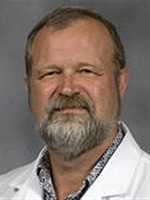Emerging migraine treatments could 'take a load off' your mind
For this country’s nearly 40 million migraine sufferers, trying to keep up with the rash of new and promising treatments could be a headache they don’t mind.
While many of these remedial late-comers are for prevention, one in particular can be taken long after the onset of these protracted and often disabling attacks. And though they have some reservations, caregivers at the University of Mississippi Medical Center have seen encouraging results.
Among these patented discoveries are three approved in 2018: Aimovig, Ajovy and Emgality, a trio of anti-CGRP (calcitonin gene-related peptides) antidotes for inflammation caused by the release of proteins.

“All are injections and all are preventive,” said Dr. Jimmy Wolfe, a UMMC assistant professor of neurology and chief of general outpatient neurology. “They all work for a fair number of people.
“The new ones work on a different mechanism than other medicines have in the past. But I can’t predict who they will work on. I know a horse is going to win a race, but I can’t tell you which horse.”

In many of her patients’ race against pain, “some of these medications have been life-changing,” said Elizabeth “Liz” Williams, a family and psychiatric nurse practitioner at UMMC. But for patients to get a prescription, other treatments must have failed them first, she said.
Also representing a breakthrough: another anti-CGRP arrival, Ubrelvy, an oral medication approved by the Food and Drug Administration in December.
“This one can be taken up to four hours after the start of the headache,” Wolfe said.
Ubrelvy, like the older migraine foe, a group of medications called triptans, is not a preventive measure; instead, it’s an abortive drug that should be taken as early as possible at the headache’s onset. It can provide considerable relief within two hours.
It thwarts the “escalation” of the pain, Williams said.
“Patients have told me they don’t get a full-blown headache.”
Compared to triptans, Ubrelvy can be taken much later following the onset of the migraine, and medically speaking, it comes with less baggage.
“For someone with hypertension or a history of cardiac disease, you wouldn’t want to write a triptan prescription,” Williams said. “That’s not the case with Ubrelvy. But so many people are using it, we have trouble getting it.”

In Mississippi, thousands of residents who experience what can feel like a ripsaw lodged in the skull could potentially benefit from Ubrelvy and the other drugs. About 8-to-10 percent of the state’s population, or between 237,000 and 297,000 people, slip down into the migraine abyss, said Dr. Anand Prem, a UMMC associate professor of anesthesiology.
“I’ve prescribed Aimovig for many patients, and some have done extremely well,” Prem said. “The CGRP treatments, especially, have played a big role in stopping what brings on a migraine headache.”
Yet no one can know how some of these new treatments will perform in the long run. Once a drug is approved by the FDA, it takes about a year of common experience among caregivers to discover how effective it really is, Wolfe said.
“Some drugs come with great lab data, but once they’re released, you find they have problems,” he said. “I’m just starting to use Ubrelvy for my patients, so I haven’t seen as many as I would like so far.”
Reyvow, a tablet for acute pain said to provide relief within two hours, is so new Williams hasn’t prescribed it yet.
All this begs the question: Why are so many migraine remedies popping up?
For one thing, the incentive to make them is as potent as the migraine itself. Headaches are one of the main reasons people bolt for the emergency room, and migraines are among the most common causes of headaches – pain so severe, the loss in workforce productivity subtracts more than $13 billion each year from the U.S. economy.
“It’s one of the leading causes of lost work,” Wolfe said. “When you have really bad headaches, it’s hard to do your job. And with some jobs, it’s not safe.”
Another reason: Researchers are getting a firmer hold on the culprit, or culprits, Prem said.
“For a long time, migraine was treated like any other headache. Research has now been able to pinpoint specific mechanisms that cause it. It’s possible to get more medications than can target those mechanisms. This has led to better treatments, and more of them.”
So has competition.
“When a drug company has a promising finding in its lab research, all the other companies start going after it,” Wolfe said. “They’re all now fighting for market share. You would hope that this would drive the price down, but it hasn’t so far.”
Without insurance, many of these new drugs cost the patient about $7,000 a year, Wolfe said. Even Botox, an off-patent treatment that requires periodic injections to dull or prevent chronic migraines, costs about the same.
“All of these drugs are very expensive if you don’t have insurance,” Wolfe said, “and even if you do, your insurance company will pick one and negotiate a price with the drug company.”
Still, relief doesn’t always have to come from a bottle or at the end of a needle, necessarily. Regular sleep and meals, hydration, stress reduction and avoiding certain foods can help the migraineur foil the triggers that can vary from person to person.
“Sometimes, it’s a detective job to find those triggers,” Wolfe said, “and the patient has to be involved in the detection. If you come to me and say, ‘I have headaches, fix me,’ I probably can’t help you.”
A patient diary can be useful, Prem said.
“You write down what you ate, what you changed: Even new perfumes or colognes or laundry detergent can bring it on. Also, tomato-based products such as pizza. Or wine, cheese or caffeine.
“The overuse of caffeine and overuse of over-the-counter headache medications can be triggers as well.”
For women, who are more likely than men to suffer the worst attacks, changes in the level of the hormone estrogen can be a factor, Prem said.
Regardless of gender, over-the-counter alternatives can help reduce the frequency of migraines and/or prevent them for some patients, Williams said. These supplements include Vitamin B2, or riboflavin; magnesium; coenzyme Q10 and more.
“I also order myofascial pain therapy for patients, a hands-on technique where physical therapists provide sustained pressure on nerves and muscles that cause chronic pain,” Williams said. “Some patients have sworn by it; others said it didn’t seem to help. But most of the patients do get some benefits from it.”
She will also recommend to certain patients a visit to a medical infusion therapy center. UMMC offers three such sites where patients receive abortive medicine through an I.V.
Some patients profit from biofeedback and mindfulness meditation as well, Prem said.
For his part, Wolfe has also prescribed FL-41 filtered lenses for patients who have headaches set off by sunlight or certain light frequencies.
“The lenses can lessen the effect of those triggers and sometimes prevent the headache or lessen its severity,” he said. “They’re about $70 to $100 a pair, a one-time investment.”
Of course, there are apps, such as RELAXaHEAD, that tutor patients in muscle relaxation techniques, Prem said. These non-medication treatments “have fewer side effects, are less expensive and are fairly effective in reducing the effects of migraines,” he said.
But the line of new and potential painkillers grows ever longer. Rimegepant Zydis, for instance, an oral remedy for acute migraines, was awaiting FDA approval at press time.
“The advantage of many of these drugs, including Botox, “is that the data shows the longer you’re on one, the better it works,” Wolfe said. “I’m seeing good results with those I’ve prescribed and I hope that patients will continue to get better.”
The above article appears in CONSULT, UMMC’s monthly e-newsletter sharing news about cutting-edge clinical and health science education advances and innovative biomedical research at the Medical Center and giving you tips and suggestions on how you and the people you love can live a healthier life. Click here and enter your email address to receive CONSULT free of charge. You may cancel at any time.



